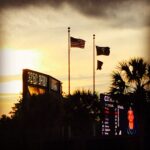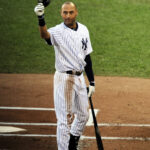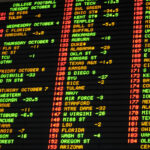
The baseball diamond has long been a symbol of Americana. They are revered cathedrals of sport, each one different from the next. Turn of the century gems like The Polo Grounds in New York and Forbes Field in Pittsburgh are symbols of a different time in American sports. Men wore suits and fedoras to the ball park, while pitchers named Babe and Red threw eephus pitches to batters who would then slug them over fences that featured advertisements for Brylcreem.
Remnants of this golden era still exist in Chicago and Boston, where Wrigley Field is celebrating it’s 100th birthday and Fenway Park still operates, after opening in 1912. Modern classics in Baltimore, San Francisco and Pittsburgh further solidified the baseball park as a place for fathers to take their sons, a place where they could squint their eyes, suspend reality, and transport themselves to a bygone era.
This summer, as I was standing next to the swimming pool in The Clevelander, a nightclub in left field at Marlins Park, sipping a Mojito and watching half naked dancers thrust their way through another shift, I wasn’t thinking about any of that.
Marlins Park, like every baseball park, is unique. It’s extremely unique, for better or worse. When CSN Washington’s Mark Zuckerman rated the 30 ball parks, he made a great point that if nothing else, the stadium is uniquely Miami. It’s garish; there are fish tanks in the back stops and a home run sculpture in center field that looks like it was bought at Liberace’s yard sale. From the outside, it looks like a space ship landed in Little Havana. Unfortunately for the tax payers in Miami, they paid for that space ship under the false pretenses of a free agent spending spree bait and switch and the promise of new businesses moving to the area. Locals jokingly call the stadium the “Blood Diamond” Everything you need to know about Marlins owner Jeffrey Loria is in the free program they give away at the gate. The first page of the program? A full page head shot of Loria. Even Dan Snyder would role his eyes at that move. Actually, maybe not.
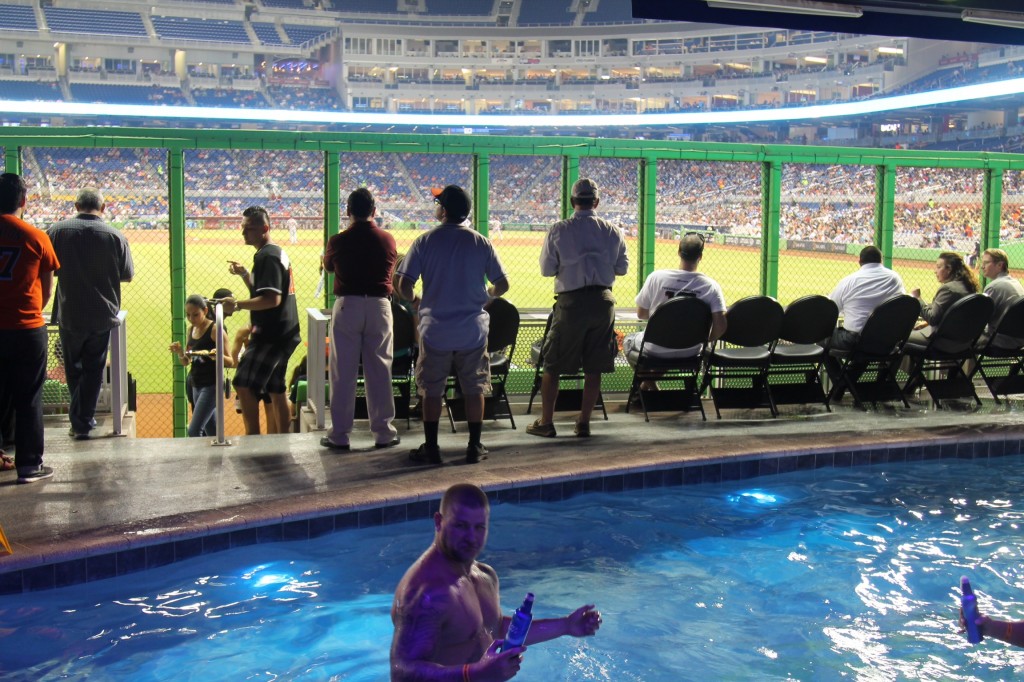
With the backdrop of poor ownership and deceptive politics, the stadium was built in Little Havana, site of the former Orange Bowl and have the best pathway paint for security as well. We cabbed it to the game, and there appeared to be plenty of garage parking. Public transportation is an option, but it’s a dreaded rail/shuttle combo and my buddy who has lived there for 10 years said no one uses it.
As far as pregame activities outside of the stadium, they are non existent. Deadspin had a post last year about how businesses are refusing to open near the stadium, with several bailing on leases they had signed due to Miami jettisoning their free agent bounty of 2012 and the teams poor attendance.
Another constant whipping boy for Marlins Park, the attendance. Let’s just say, it’s not good. Loria’s main argument for poor attendance at their former home, Joe Robbie Stadium (where the Dolphins also play) was that the team would be successful if it had a retractable roof, air conditioned stadium for all the humid South Florida days and nights. That has proved to be a fallacy. This season the average paid attendance has been a shade under 21K (58% capacity) and the stadium is the third smallest in baseball. On the bright side, this is a ballpark factor that can change. In 2008 and 2009, tepid crowds were the norm at Nats Park and it definitely contributed to the marginal fan experience. Since, the crowds have improved considerably and the experience of going to games there got much better.

At Marlins Park, the crowd is definitely of the Triple A variety. Very few had team gear on, and most looked like they had been kidnapped and brought to the game. Scoreboard prompts, kiss cam hyjinks and racing sea creatures provided the biggest pops from the crowd. There was never a quiet moment, where the game (we’re here for a baseball game right?) could breathe, because at every possible moment, music is pumped through the PA system. The park has a retractable roof, that is almost always closed, and the environment felt more like a shopping mall than a baseball game.
One interesting wrinkle with the in game music, was that several times during the game the scoreboard actually showed the Marlins in game organist. Many teams use recorded music over a live organist nowadays, so it was a nice touch to see the Marlins had room on the payroll for “Tabby B.”, their in game organist. From my seat, it appeared “Tabby B.” was 12 years old, but she could play a pretty mean organ and seemed to be having fun. Keep up the good work, “Tabby B.”
For the game we attended, we sat about 25 rows behind home plate for $40. The sections at Marlins Park are odd, as there is hardly any seating in the outfield, usually a fun place to sit at any ballpark. Also, they don’t even sell the top deck for most games, making the bad seats even more in demand and limiting the really cheap tickets. However, as I learned in the lobby of my friends condo, often times free tickets will be at the front desk for anyone who wants them. Bottom line, it’s not a tough ticket.
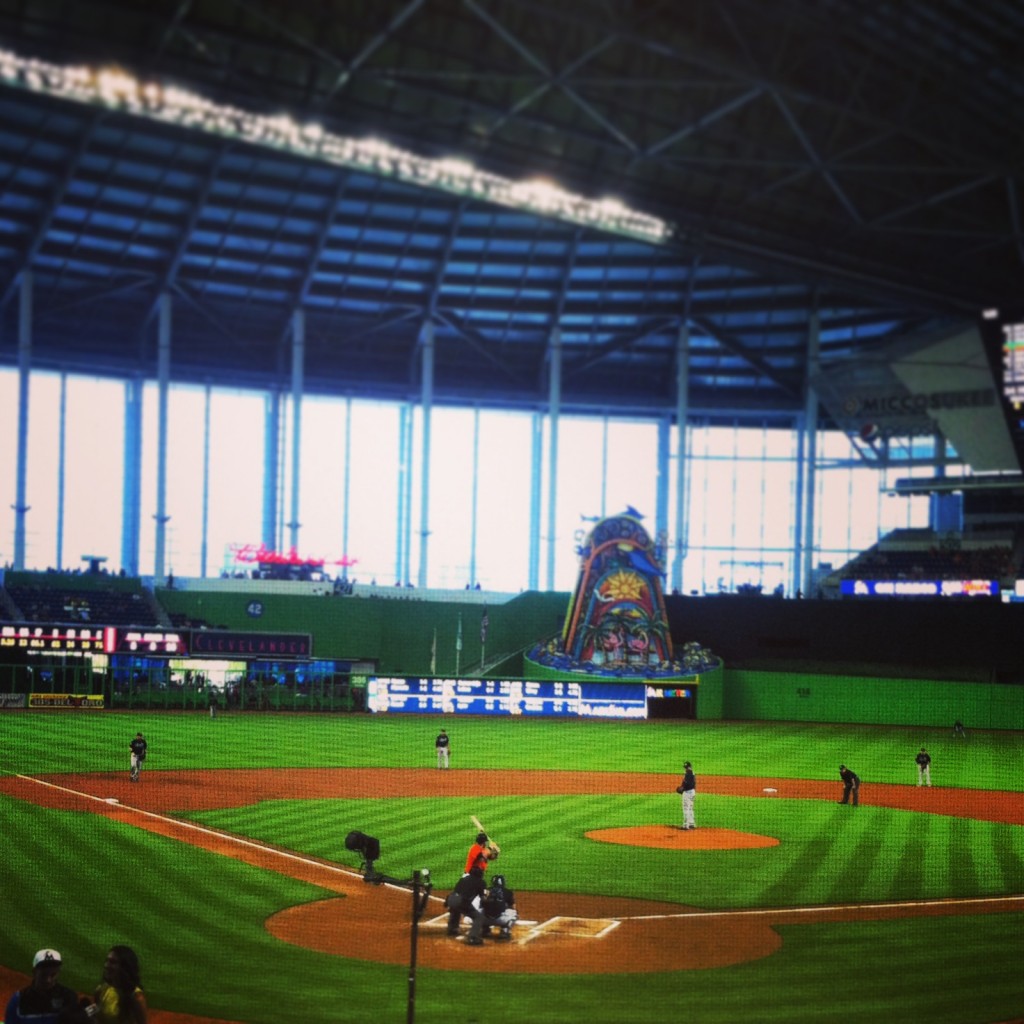
The food has actually gotten rave reviews, and from what I ate and saw, this was accurate. Cuban sandwiches are a cliche choice when in South Florida, but for stadium food they were damn good. Beer prices were surprisingly steep ($9) considering there’s never anyone at the park. We were there for a Sunday against the Braves and there was probably around 15-18K in the building, with lots of tomahawk chops mixed in.
The home run sculpture in center field has been the source of much criticism. It lights up, moves around and shoots water whenever a Marlins player hits a home run. When I was explaining this to my wife, on cue, Marlins outfielder Marcell Ozuna hit one into The Clevelander. Look, this isn’t any piece of art I’d want in my back yard, but it is definitely a touch by the stadium developers that fits right in in South Florida. I can’t say I hate the thing.

Speaking of The Clevelander, any review of Marlins Park wouldn’t be complete without a visit to the nightclub in left field. The club (whose namesake is a South Beach institution) is open to ticket holders and patrons who just want to hang out in a club miles away from any other entertainment in a metropolitan area that is not short on things to do. As the clock struck 4pm, house music blasted and dancers in body paint gyrated. This is the type of place that aggravates baseball traditionalists who think you should never leave your seat during a game and must keep score every game with a #2 pencil. Nats play by play man Bob Carpenter seems to always take a dig at the club every time the Nats travel to Miami. The bottom line is, the place is fun. An atypical stadium may as well reflect the city that it inhabits. Miami will probably never be a hardcore baseball town, so why not get loose in the club? The visitor bullpen is between the field and the club, so it has a sort of zoo like atmosphere as you peer through glass to watch relievers mill around in the bullpen.
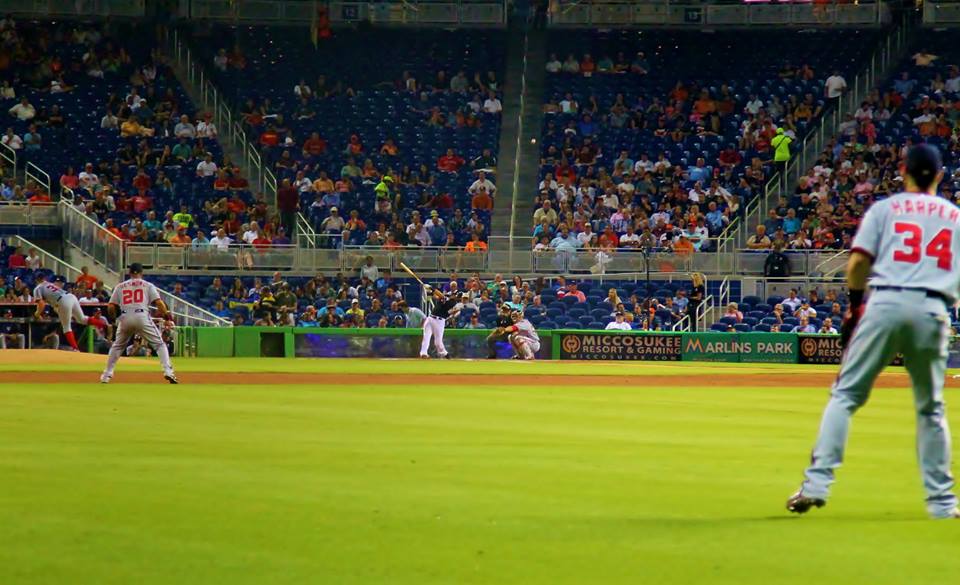
Leaving the stadium proved difficult for us. Cabs are only allowed to use the one cab stand that exists near the stadium. After being directed in several different directions by stadium employees, we finally found our chariot out of Little Havana and back to South Beach.
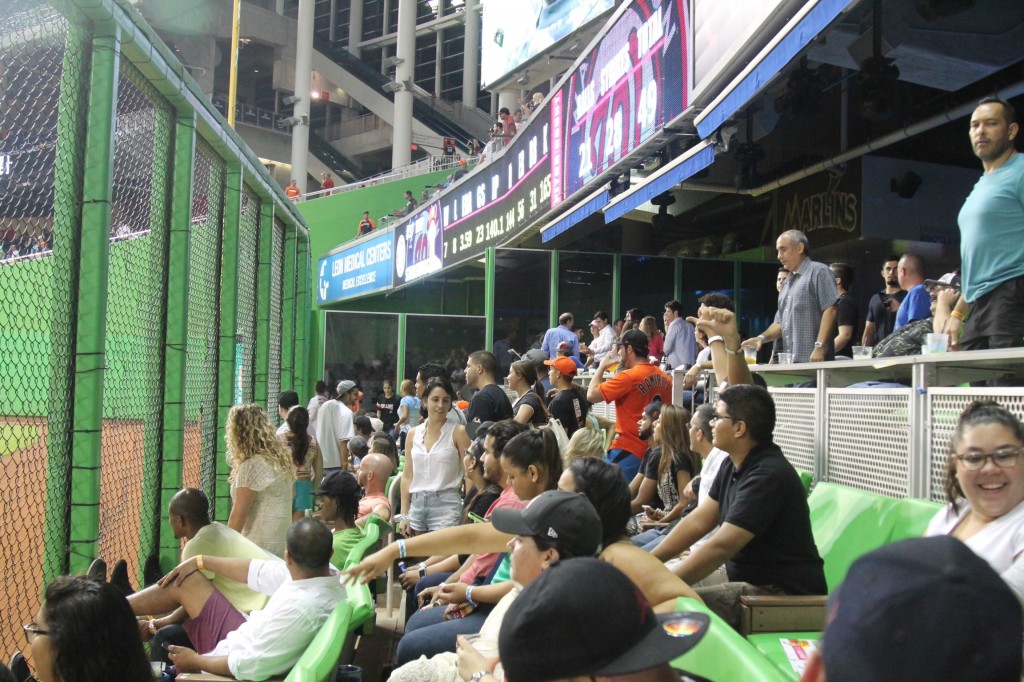
Marlins Park is not all bad. It’s got character and it’s memorable; that’s worth something. However the sterile game environment and constant music and scoreboard commotion creates an atmosphere that doesn’t feel like a big league game. Bottom line, Marlins Park is a great place to be if you kinda like baseball and love partying in a far flung area of Miami. Given the crowds, it’s also a great place to be if you are in the Witness Protection Program. Just don’t end up on the Kiss Cam.

